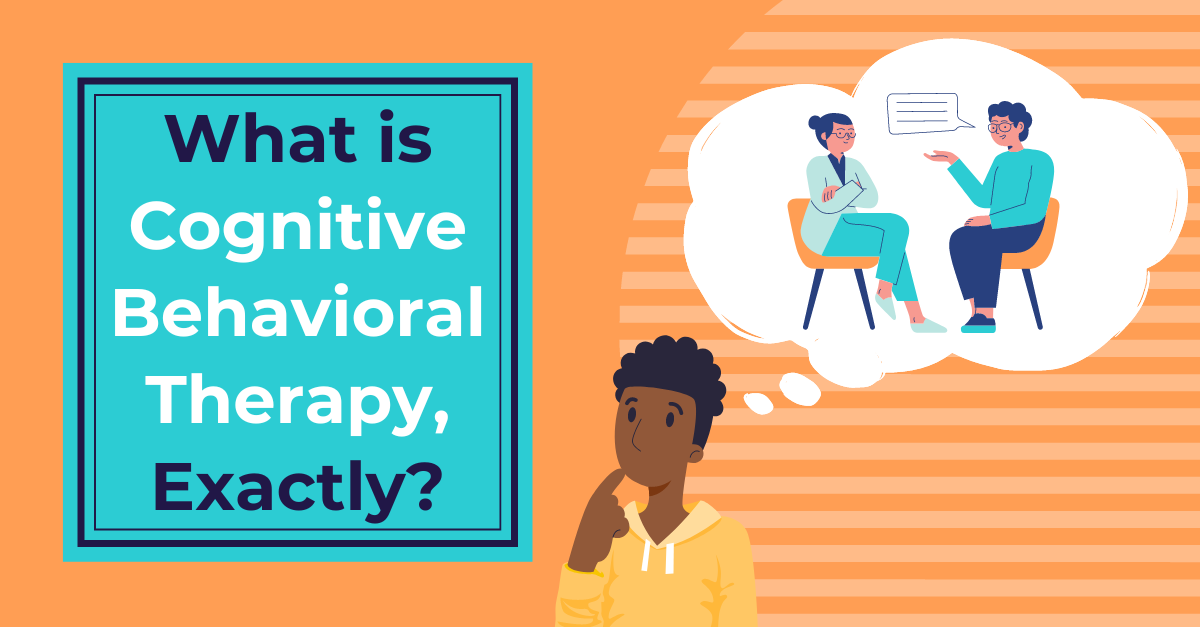September 30th, 2022

Cognitive Behavioral Therapy (CBT) is considered the “gold standard” psychotherapy for anxiety and depression, and research has shown it is effective for treating many other mental health conditions.
But what is it exactly?
CBT, quite literally, is a combination of cognitive therapy and behavioral therapy. For many people, symptoms of depression and anxiety have become a part of daily life, but that does not need to be the case. CBT teaches us that the way we think, feel, and behave are all connected.
For example, thinking “nobody likes me,” can lead to feeling anxious about attending an event, and then lead to avoiding attending the event. CBT promotes positive behavioral change and growth, by helping us to recognize and change negative thought patterns that impact our emotions and behaviors. It’s a time-limited, goal-oriented treatment, which means many people experience improvement in symptoms and daily functioning faster than they may with other forms of treatment.
Using CBT skills can also be helpful for those who don’t have a mental health disorder. By changing the way you think about your experiences, you can improve your mood and take actions that are consistent with your goals, and improve your life.

Cognitive Behavioral Therapy differs from other psychological treatments in several ways.
First, while many traditional forms of talk therapy like psychodynamic therapy focus on past experiences and unconscious processes, CBT is present-oriented and encourages clients to focus on the here and now. This allows for faster symptom reduction and improvement in daily functioning by focusing on learning skills that target current thoughts, emotions, and behaviors.
Second, while the duration of therapy is not always specified in other forms of therapy, CBT typically involves 12 to 20 sessions. This varies from person to person based on your goals and needs.
Third, CBT involves a collaborative approach between the therapist and the client. Unlike other forms of therapy that involve the therapist taking an expert role and leading you through treatment, in CBT the therapist works with you to recognize patterns in your thoughts and behaviors, set goals, solve problems, and learn skills. This is called collaborative empiricism, and research has shown that it is one of the main reasons CBT is so effective.
Lastly, the goal-oriented nature of CBT allows you to identify the changes you would like to make, such as reducing anxiety, improving motivation, or decreasing negative behaviors. You will then work as a team with your therapist to find the right combination of skills to meet your goals. An eventual goal of CBT is for you to learn to help yourself, and essentially you become your own therapist by using the skills you have learned in therapy to view and approach situations in more positive and adaptive ways.

CBT is effective for children, adolescents, and adults. Research has found it is just as effective as other forms of therapy, and in some cases for specific disorders, more effective. It can be used alone or combined with psychiatric medication. It works by helping people to change behaviors, develop new coping strategies, and change negative and unhelpful ways of thinking and seeing situations.
This is done in several ways, some of which include cognitive restructuring, self-monitoring, goal setting, behavioral activation, relaxation and mindfulness, and exposure.
Cognitive restructuring is often the first skill learned, and it involves identifying and challenging negative thoughts. In CBT negative thoughts are referred to as cognitive distortions. Examples include:
These thoughts are often experienced as automatic, and with the help of your therapist, you can learn to identify them and eventually challenge and reframe them.
Challenging these thoughts involves asking yourself questions when these thoughts occur, such as:
By asking ourselves these questions, we are often able to recognize that these negative thoughts are not true, which puts us in a place to reframe them by thinking about the situation in a positive or neutral way.
Self-monitoring involves tracking behaviors, symptoms, or experiences over time and reviewing this log with your therapist to help recognize your patterns of behavior and changes you make over time. Goal setting in CBT involves SMART goals, which are goals that are Specific, Measurable, Attainable, Relevant, and Time-based. Behavioral activation involves scheduling activities that you enjoy to help improve your mood. Exposure is a behavioral technique that involves facing an object or situation that causes fear or anxiety, through imaginal or in vivo exposure exercises. Relaxation and mindfulness skills involve engaging in deep breathing exercises, progressive muscle relaxation, and meditation to help calm the mind and body.

CBT can involve one-on-one or group sessions. As mentioned above, it is a time-limited, goal-oriented, and collaborative approach. Each session is structured based on the goals set during your first session when your treatment plan is created. During your first session, your therapist will ask questions to learn about your life and experiences and your goals for therapy, which will help the two of you develop goals and create your treatment plan. They will also provide education about your disorder and the treatment process.
In the following sessions, your therapist will help you learn skills to cope with symptoms, check in with you about your progress on SMART goals, and review behavior logs and homework assignments in order to help you gauge your progress and modify the treatment plan as needed.
A CBT treatment plan involves identifying one or more problems or symptoms that you want to target, and then identifying a long-term goal and multiple short-term goals related to this problem or symptom. For each short-term goal, you and your therapist will select a date you plan to achieve the goal by. This can be modified as treatment continues. You will then identify the interventions, which include the actions and skills you plan to engage in to meet these goals. Lastly, you will set dates to review the treatment plan together during your upcoming sessions.

Research has found that CBT is effective for a wide variety of mental health issues including:
It is also effective for emotional concerns that involve relationship issues, divorce, grief and loss, low self-esteem, anger issues, and stress management.
Lastly, CBT can be helpful in managing chronic pain and chronic health issues including fibromyalgia, irritable bowel syndrome, and chronic fatigue. If you are experiencing any of these issues, cognitive behavioral therapy can be a very effective treatment option for you.
Written by: Dr. Nicole Ortiz, Ph.D.
At Clarity Clinic, we have highly trained staff who specialize in therapy and psychiatry services. To learn more about how we can support your mental health, call Clarity Clinic at (312) 815-9660 or schedule an appointment today.
Our Services
Virtual/Online CarePHP and IOPAdult PsychiatryChild & Adolescent PsychiatryAdult TherapyChild & Adolescent TherapyCouples CounselingFamily TherapyGroup TherapyPsychological TestingTranscranial Magnetic Stimulation (TMS)